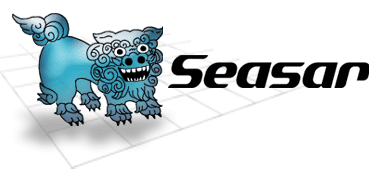S2ApplicationContextの主な機能は次になります。
- s2componentメソッドで登録されたコンポーネントからS2Containerの生成
- アスペクトの自動設定
- S2Container内における名前空間(namespace)単位でのコンポーネント登録
- 名前空間(namespace)単位でのにSingleton S2Containerインスタンス管理
S2ApplicationContextの生成は、instanceメソッドで行います。
S2ApplicationContext#instance
instanceメソッドでS2ApplicationContextを生成した場合は、Singletonインスタンスが返ります。 新規インスタンスを生成する場合は、newメソッドを使用して下さい。
S2ApplicationContext#new
S2ApplicationContext#instanceメソッドへのショートカットとしてs2appメソッドが定義されています。
s2componentメソッドを用いてクラスをコンポーネントとして登録します。
s2component(options = {}, &procedure)
alias s2comp s2component
- 第1引数 : コンポーネントの情報 (Hash)
- Symbol :class => コンポーネントのクラス
s2componentメソッドがクラス定義内で呼ばれた場合は、そのクラスがデフォルト値として設定されます。- Symbol :name => コンポーネント名 (String | Symbol)
- Symbol :instance => インスタンス管理設定
- Symbol :autobinding => 自動バインディング設定
- Symbol :namespace => S2Container内での名前空間設定 (String)
- 第2引数 : コンストラクタ ブロック
コンポーネントの生成処理を含むブロックです。ブロックの最後の評価値は、第1引数の:classで指定したクラスとis_a?関係とならなければいけません。s2componentメソッドは、コンポーネントクラスに「instance」クラスメソッドを定義します。 「instance」 クラスメソッドは、S2Containerからコンポーネントを取得し返します。
require 's2container' class Action s2component end action = Action.instance # instanceクラスメソッド内でs2app.get(Action)が実行される
S2Containerインスタンスの生成は次のメソッドで行います。
S2ApplicationContext#create(namespaces = [])
生成されるS2Containerは、s2componentメソッドで登録した全クラスをコンポーネントとして持ちます。 namespaces引数(文字列、文字列の配列)を設定した場合は、指定されたnamespaceを含むS2Containerインスタンスが返されます。 例として、グローバル(namespace指定無し)にActionクラスがあり、services namespaceにServiceクラスが ある場合は、次のようにS2Containerを生成できます。
クラスの定義は次になります。
module Example class Action s2comp end class Service s2comp :namespace => "services" end end実行スクリプトは次になります。
require 's2container' require 'example' // グローバルコンテナの生成 container = s2app.create component = container.get(Example::Action) p component component = container.get(Example::Service) p component // services namespace コンテナの生成 container = s2app.create("services") begin component = container.get(Example::Action) # -> コンポーネントが存在しないのでエラーとなります。 rescue => err puts err.message end component = container.get(Example::Service) p component
![[注意]](../../images/docbook/note.png) | NOTE |
|---|---|
|
この例は example/example05 にあります。 |
createメソッドでS2Containerを生成する際に、s2componentメソッドで登録されたクラスから一部を選択することができます。
- default (パターン設定無し) : 登録された全てのクラスをコンポーネントとしてincludeします。
- Include Pattern : 登録されたクラスに対してパターンにマッチするもののみを使用します。
- Exclude Pattern : 登録されたクラスに対してパターンにマッチするものは除外します。
- Include & Exclude : Include PatternとExclude Patternが両方設定されている場合は、Include PatternにマッチしたものからExclude Patternにマッチしたものが除外されます。
include メソッド.
S2ApplicationContext.include(pattern)
- 第1引数 : include パターン
- 正規表現 : コンポーネント名、コンポーネントのクラス名にmatchした場合にincludeします。
- クラス : コンポーネントクラスと等しい場合にincludeします。
- 文字列 : コンポーネント名、コンポーネントのクラス名に等しい場合にincludeします。
- Symbol : コンポーネント名、コンポーネントのクラス名のSymbolに等しい場合にincludeします。
excludeメソッド.
S2ApplicationContext.exclude(pattern)
- 第1引数 : exclude パターン
- 正規表現 : コンポーネント名、コンポーネントのクラス名にmatchした場合にexcludeします。
- クラス : コンポーネントクラスと等しい場合にexcludeします。
- 文字列 : コンポーネント名、コンポーネントのクラス名に等しい場合にexcludeします。
- Symbol : コンポーネント名、コンポーネントのクラス名のSymbolに等しい場合にexcludeします。
コンポーネントの選択でインクルードされたコンポーネントに対して、自動的にアスペクトを適用します。 自動アスペクトの設定は、s2aspectメソッドで行います。
s2aspect(options, &procedure)
- 第1引数 : アスペクト情報をHashで設定します。
- Symbol :pattern => デフォルト値は Regexp /.+/ です。
- 正規表現 : コンポーネント名、コンポーネントのクラス名にmatchした場合にaspect対象となります。
- クラス : コンポーネントクラスと等しい場合にaspect対象となります。
- 文字列 : コンポーネント名、コンポーネントのクラス名に等しい場合にaspect対象となります。
- Symbol : コンポーネント名、コンポーネントのクラス名のSymbolに等しい場合にaspect対象となります。
- Symbol :pointcut => デフォルト値は Regexp /.+/ です。
- 正規表現 : メソッド名にmatchした場合にaspect対象となります。
- 文字列 : メソッド名に等しい場合にaspect対象となります。
- Symbol : メソッド名に等しい場合にaspect対象となります。
- Symbol :interceptor => Interceptorコンポーネント名、またはInterceptorインスタンス
- 第2引数 : Interceptor ブロック
Interceptor処理を含むブロックです。引数はMethodInvocationインスタンスです。MethodInvocationのproceedメソッドで 次のInterceptor処理、あるいはアスペクト対象のメソッドを実行します。
s2aspectメソッドがクラス定義内で実行された場合は、第1引数の:pattern値に文字列でクラス名が自動設定されます。
ActionクラスのindexメソッドにTraceInterceptorをアスペクトする場合を次に示します。 TraceInterceptorは、予め 「interceptor.trace」としてコンポーネントが登録されています。
module Example
class Action
s2comp
s2aspect :interceptor => "interceptor.trace", :pointcut => :index
def index
s2logger.debug(self.class.superclass) {"index action called."}
end
end
end
実行スクリプトは次になります。
require 's2container' require 'example' container = s2app.create component = container.get(Example::Action) component.index
![[注意]](../../images/docbook/note.png) | NOTE |
|---|---|
|
この例は example/example06 にあります。 |
ActionクラスのindexメソッドにブロックでInterceptorをアスペクトする場合を次に示します。
module Example
class Action
s2comp :name => :action
def index
s2logger.debug(self.class.superclass) {"index action called."}
end
end
end
実行スクリプトは次になります。
require 's2container'
require 'example'
s2aspect(:pattern => :action, :pointcut => :index) {|invocation|
s2logger.debug(invocation.component_class) {"before"}
result = invocation.proceed
s2logger.debug(invocation.component_class) {"after "}
next result
}
container = s2app.create
component = container.get(:action)
component.index
![[注意]](../../images/docbook/note.png) | NOTE |
|---|---|
|
この例は example/example07 にあります。 |
S2ApplicationContextは、namespace単位でSingleton S2Containerを生成、管理します。 Singleton S2Containerへのアクセスは次のメソッドで行います。
get_componentメソッド.
S2ApplicationContext#get_component(key, namespaces = []) alias component get_component alias get get_component
- 第1引数 : コンポーネントキー
- 第2引数 : S2Containerを管理するnamespaces
第1引数で指定されたコンポーネントを取得します。 第2引数で指定されたnamespaceを含むSingleton S2Containerが未作成の場合は、S2ApplicationContext.createメソッド を用いてコンテナを生成します。
get_component_defメソッド.
S2ApplicationContext#get_component_def(key, namespaces = [])
- 第1引数 : コンポーネントキー
- 第2引数 : S2Containerを管理するnamespaces
第1引数で指定されたコンポーネント定義を取得します。 第2引数で指定されたnamespaceを含むSingleton S2Containerが未作成の場合は、S2ApplicationContext.createメソッド を用いてコンテナを生成します。
例として、グローバル(namespace指定無し)にActionクラスがあり、services namespaceにServiceクラスが ある場合は、次のように 各コンポーネントを取得できます。
クラス定義は次になります。
module Example
class Action
s2comp
end
class Service
s2comp :namespace => "services"
end
end
実行スクリプトは次になります。
require 's2container' require 'example' global_action = s2app.get(Example::Action) p global_action global_service = s2app.get(Example::Service) p global_service begin services_action = s2app.get(Example::Action, "services") rescue => err puts err.message # -> component [Example::Action] not found. end services_service = s2app.get(Example::Service, "services") p services_service p global_service == services_service # -> false
![[注意]](../../images/docbook/caution.png) | 注意 |
|---|---|
|
グローバルのSingletonコンテナが生成される際にservices namespaceのコンテナも生成され、子コンテナとして保持されていますが、 services namespaceのSingletonコンテナとは別インスタンスとなります。 |
![[注意]](../../images/docbook/note.png) | NOTE |
|---|---|
|
この例は example/example08 にあります。 |
